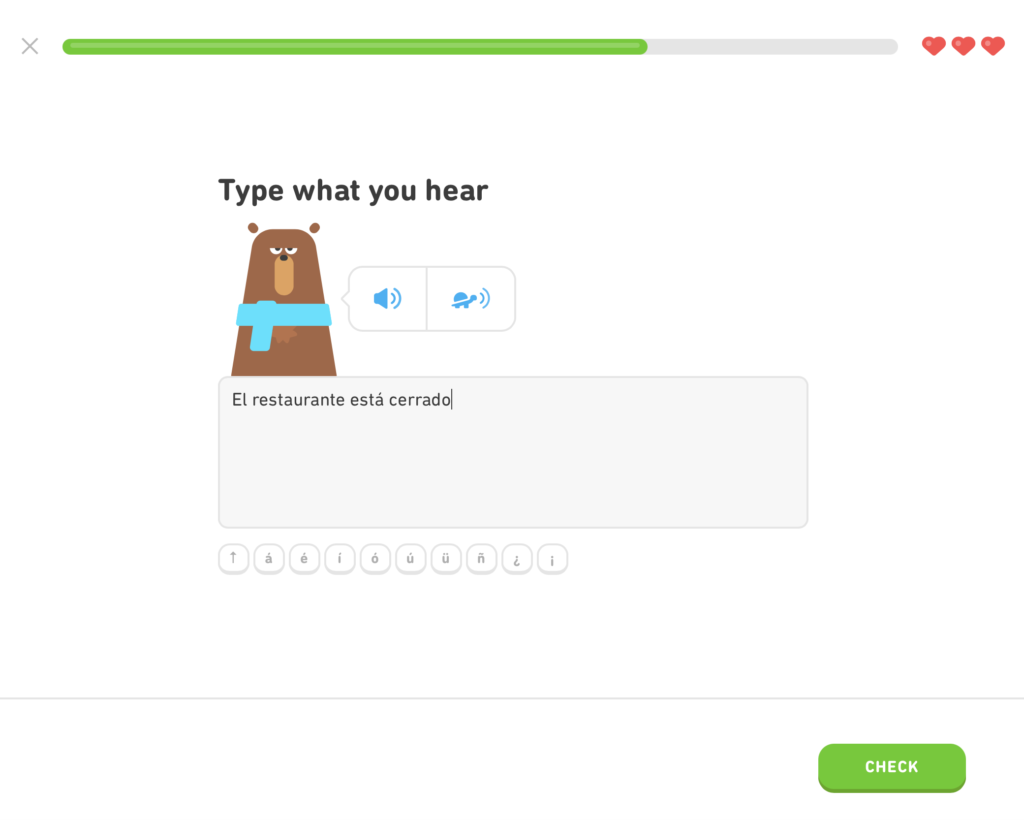Duolingo is the most well known language learning platform, and was established in 2011. It’s available in a web version, as well as for iOS, Android and Windows Phone, and it has around 500 million users.
Duolingo uses a fun and interactive method of lessons that combine speaking, reading, writing, and listening. While this makes it interesting, Duolingo won’t make you fluent in Spanish. It lacks a focus on grammar and uses strange vocabulary that makes it good for a complementary but not primary source of learning.
If you’re an English speaker, you can learn Spanish, French, German, Italian, Russian, Portuguese, Turkish, Dutch, Irish, Danish, Swedish, Ukrainian, Esperanto, Polish, Greek, Hungarian, Norwegian, Hebrew, Welsh, Arabic, Latin, Hawaiian, Scottish Gaelic, Vietnamese, Korean, Japanese, Romanian, Indonesian, Finnish, Yiddish, Czech, Swahili, Navajo, Haitian Creole, Klingon, Hindi, Chinese and even High Valyrian on Duolingo.

Users have a lot of questions about Duolingo. Its efficiency is contested by some and praised by others. In this article we’re gonna focus in Spanish and see what people say about learning it in Duolingo.
What type of Spanish is taught in Duolingo?
According to the Duolingo forum, in the app “you’ll learn a version of Spanish closer to what you’d hear in Latin America than in Spain“. After testing it myself as a native Spanish speaker, I have to kind of disagree.
I say kind of because that Spanish is definitely closer to Latin American Spanish than to Spanish from Spain. However, the Spanish duolingo offers sounds very similar to what we call “neutral” Spanish. It’s a kind of Spanish that isn’t spoken anywhere but that we all understand, and it’s mostly present in dubbed movies.
Also, the term “Latin American Spanish” is way too broad, because there’s 19 Spanish speaking countries in Latin America and not all of them speak similarly. Nonetheless, I do find the Spanish in Duolingo to be a bit Mexican, specially from the accent that some of the audios have.
Is Duolingo good for Spanish?
I mean, it depends on what you wanna use it for. Duolingo uses “trees” tailored to the target language, with specific skills to practice vocabulary, grammar, and pronunciation using spaced repetition.
Exercises include written translation, reading and speaking comprehension, and short stories.
The main pro about Duolingo is that it’s free. It also has a plus version that costs around 86 CHF per year in Switzerland, around $90-95. If you want to pay monthly, it will cost you 12 CHF a month in Switzerland. So if you like the free version too much, you might want to upgrade to the plus version.
| PROS | CONS |
|---|---|
| Free version | Caps on daily mistakes (free version) |
| Interactivity in lessons | Lack of grammar focus |
| Short stories | Adverts |
| Lessons are short thus not tedious | Strange vocabulary |
How does Duolingo work?
Let’s take a look first at what a Duolingo lesson in Spanish looks like. They include:
Listening exercises where you might have to type what the speaker is saying, or select the correct word. It can be a single word or even a full sentence. You can listen to the audio in a slower speed if you need to.

Writing exercises where you translate a full sentence from English to Spanish, or even viceversa. If you have small spelling mistakes but you were grammatically correct, they will give you the correct point. Which I find great.


Other exercises such as fill in the blanks with images to help you, match the pairs, or picking the correct word.

Speaking exercises where you repeat what the native speakers tell you. If Duolingo thinks your pronunciation is not correct, you’ll have to repeat the exercise later.
What I find positive about the lessons is how interactive they are. That helps me think I’m doing them quickly.
It its true, though, that I sometimes find the language to be a bit odd sometimes, using weird sentences or vocabulary that you wouldn’t say in “real life”.
Duolingo pros and cons
As a native Spanish speaker, I wanted to try the Spanish course in Duolingo to see how I liked it. I’ve put up a list of pros and cons of the things I enjoyed less and more.
pros
Free version: yes, the ads are very annoying. But let’s be honest, being able to learn a language for free sounds like a good deal. That said, I will cover the cons of the free version below.
Interactivity in lessons are great, because they make me stay focused on the lesson and it feels like I finish them quickly, what makes me want to do a next one after. That happens to many people, so we can say that they nailed the aspect of keeping you in the app.
I also like the variety in the exercises. The lessons are also short, which is great because you can complete one on a short commute on public transport, for example.
I also love the short stories. They’re also interactive, because while they tell the story they also make you questions to make sure you’re following it correctly. They also include exercises where you need to form the sentence you hear, with the words they give you, and matching pairs exercises too.
CONS
The free version has its cons too. There is a cap limit daily on how mistakes you can make, which are three. After you make more than three mistakes, you need to either wait to the next day or to upgrade to Duolingo plus.
The adverts in the free version are also quite annoying. They are mostly related to updating to Duolingo plus, but they also include brands ads. They have recently added video adverts that you can’t skip until they finish, which are the ones that I like less.
What I like the least about Spanish in Duolingo is the strange vocabulary they use sometimes, and the also strange voices they chose. There is a character in Spanish that’s a teenager that visibly sounds annoyed with life (makes sense, because she’s a teenager).
It was fun at the beginning but it turned very annoying at some point. I also believe one of the voices they use is not a native speaker. That would not be a problem of course, but the pronunciation is very odd, I even struggled understanding it.
As for the strange vocabulary, Duolingo uses (at least for Spanish) expressions that you won’t really use in real life, because they’re simply strange. There’s a very funny one that says ¡No necesito leer tus términos y condiciones para aceptarte!, which means “I don’t need to read your T&C’s to accept you!”. Sure, it’s funny, but you’ll most likely never say that.
They also don’t focus on grammar, which I think is a disadvantage. Grammar is fundamental in any language and although it’s the most tedious to learn, it’s also one of the most useful aspects.

Is Duolingo good for conversational Spanish?
I would not say so. Duolingo will teach you vocabulary and some phrases, but I will definitely not make you conversational.
I even think the short stories are one of the most useful resources they have, because you can follow how a conversation would go. Of course those conversations are not even always realistic, but they get close.
Native Spanish Duolingo verdict
After trying Spanish in Duolingo as a native Spanish speaker, I wouldn’t recommend it as a primary source of learning. Duolingo is more about interactivity and having fun, so it will give you some vocabulary and phrases but not substantial learning. I would say it’s good as a complementary source, since you definitely need to learn some grammar to learn a language.
Plus, Duolingo Spanish has some strange vocabulary that can be confusing for beginner learners. Their accent is also very “neutral”, which is definitely an advantage but it’s an accent that no one really speaks.
I’m not trying to discourage you from trying it, because all methods work differently for everyone. But I would for sure keep an eye for other Spanish language sources, since Duolingo won’t make you conversational in Spanish.
Let me know in the comments if you tried Duolingo to learn Spanish and how your experience was.